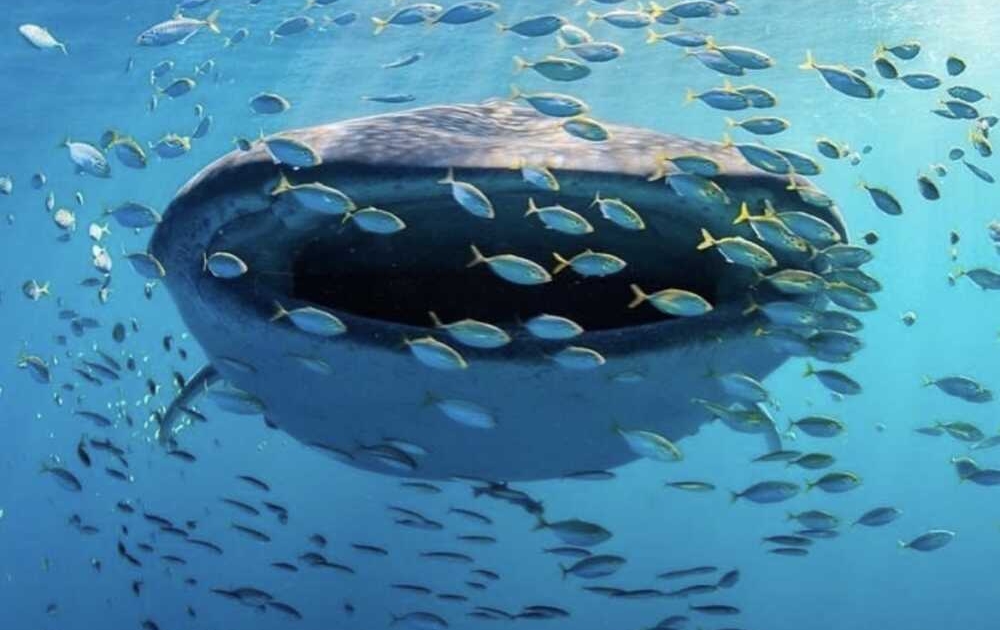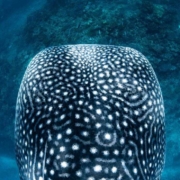The Wonder of Whale Sharks
Whale sharks are beautiful creatures with their spotty patterned skin. These spots are unique to each individual (just like our fingerprints) and can be used for identification.
Rhincodon typus, or whale sharks, are the biggest fish in the sea…and BIG fish make for BIG eaters. Big eating also requires a BIG mouth! Indeed, they have one of the largest mouths in the world – stretching open 1m wide. Their diet mainly consists of small organisms like shrimp, krill, schooling fish, plankton, and algae. They often feed in the cold deep waters off the reef, down to 600m or more. Because they are cold blooded animals, whale sharks quickly lose body temperature and become lethargic down at these depths. To warm back up and help digest their food, the whale sharks ascend to the shallow waters along the reef crest. Here at the surface, whale sharks like to sunbathe while they recover from their deep dives, and this is where the greatest opportunity to swim with a whale shark arises!
Whale sharks are docile and approachable, which makes them a common attraction for tourists. While it is a dream for many to swim with whale sharks, it’s important to follow to correct code of conduct to ensure the shark is not disturbed. We spoke to conservation biologist Kaushik Subramanian (@kaushman) who completed his master’s thesis on whale shark eco-tourism in the Maldives, and the impact this has on whale shark health. The area of the Maldives that Kaush completed his research in, is one of the only places in the world where there is a year-round population of whale sharks, and this drives a huge demand for tourist excursions to swim with them.
“My research focused on the impacts of breaking the code of conduct rules for whale shark
encounters. I would film interactions between tourists and whale sharks and record the reactions of whale sharks in response to breaches of these rules. My results showed that encounter duration is significantly affected by code of conduct breaches and that whale sharks showed adverse reactions in 97% of instances”.
Here are some ways you can ensure a pleasant whale shark encounter for both you and the whale shark…
1. Look, but don’t touch.
It’s very important not to touch a whale shark. They are not tactile animals and will retreat
to deeper water as a result of being disturbed. This is stressful for the whale shark and will
also result in the end of your encounter. Always make sure to appreciate them with your
eyes only!
2. Keep to the side.
Always keep to the side of the whale shark, swimming alongside its pectoral fins. Keep away
from the shark’s head and avoid swimming in front of the shark or blocking its path. We
shouldn’t do anything that forces the shark to change its direction or behaviour.
3. Give it space.
Stay at least 3m from the body, and 4m from the tail. This prevents accidental contact with
the swinging tail… or the body, should the shark abruptly turn.
4. No flash.
Did you really swim with a whale shark if you don’t have a photo to prove it? Taking pictures
of a whale shark is all good and can be super helpful for identifying the shark if you capture
the standard parts of the body for identification – behind the gills and above the pectoral fin.
However, always make sure flash is turned off before taking photos. Flash photography will
cause disturbance and may damage the whale sharks’ eyes.
5. Stay calm and quiet.
Keep noise to a minimum and enter the water slowly without jumping. Keep fins under the
surface while you kick to reduce splashing. Snorkel calmly and never chase the whale shark.
This ensures that disturbance is kept to a minimum and will also mean that the shark is likely to swim slowly along the reef for the longest possible time and everyone will have a lovely encounter.
Written by Bennath Chillingworth

Natalie Lobartolo is a Master Reef Guide, Dive Instructor, Marine Biologist and founder of Reef Connect. She is passionate about helping you discover the reef and spreading the word about marine conservation.



